Effect of Flow-Induced Shear Stress in Nanomaterial Uptake by Cells: Focus on Targeted Anti-Cancer Therapy
Abstract
1. Introduction
2. Physiological Shear Stresses Affecting the Tumor Cells
2.1. Shear Stress Due to Blood Flow
2.2. Shear Stress Due to Interstitial Fluid Flow
2.3. Important Aspects for the Development of Nanomedicine for Targeted Cancer Therapy
3. Interactions between Nanoparticles and Cancer Cells
4. Shear Stresses and Cellular Uptake of Nanomaterials for Cancer and Normal Cells
5. Conclusions
Funding
Acknowledgments
Conflicts of Interest
References
- Di Mauro, M.; Esposito, S.; Naddeo, A. When Physics Meets Biology: A Less Known Feynman. Transversal Int. J. Hist. Sci. 2018, 4, 163. [Google Scholar] [CrossRef][Green Version]
- Conde, J. The Golden Age in Cancer Nanobiotechnology: Quo Vadis? Front. Bioeng. Biotechnol. 2015, 3, 1–4. [Google Scholar] [CrossRef] [PubMed]
- Athulya, K.; Anitha, T. Recent Advances in Nano Biotechnology: A Review. Int. J. Adv. Sci. Res. 2017, 2, 15–17. [Google Scholar]
- Hussein, E.A.; Zagho, M.M.; Nasrallah, G.K.; Elzatahry, A.A. Recent Advances in Functional Nanostructures as Cancer Photothermal Therapy. Int. J. Nanomed. 2018, 13, 2897–2906. [Google Scholar] [CrossRef]
- Hejmadi, M. Introduction to Cancer Biology; Garland: New York, NY, USA; Prentice Hall Publishing: Upper Saddle River, NJ, USA, 2010. [Google Scholar]
- Nyoung, D.; Hyeok, D.; Moon, H.; Bok, J.; Soo, M.; Cheon, S.; Jun, W.; Sun, I.; Keun, I. Biomaterials Gold Nanoparticles Surface-Functionalized with Paclitaxel Drug and Biotin Receptor as Theranostic Agents for Cancer Therapy. Biomaterials 2012, 33, 856–866. [Google Scholar] [CrossRef]
- Kumar, A.; Ma, H.; Zhang, X.; Huang, K.; Jin, S.; Liu, J.; Wei, T.; Cao, W.; Zou, G.; Liang, X. Biomaterials Gold Nanoparticles Functionalized with Therapeutic and Targeted Peptides for Cancer Treatment. Biomaterials 2012, 33, 1180–1189. [Google Scholar] [CrossRef] [PubMed]
- Binh, L.; Yoshitomi, T.; Matsui, H.; Nagasaki, Y. Biomaterials Development of an Oral Nanotherapeutics Using Redox Nanoparticles for Treatment of Colitis-Associated Colon Cancer. Biomaterials 2015, 55, 54–63. [Google Scholar] [CrossRef]
- Yang, Y.; Lin, Y.; Di, D.; Zhang, X.; Wang, D.; Zhao, Q.; Wang, S. Gold Nanoparticle-Gated Mesoporous Silica as Redox-Triggered Drug Delivery for Chemo-Photothermal Synergistic Therapy. J. Colloid Interface Sci. 2017. [Google Scholar] [CrossRef]
- Buchanan, C.F.; Voigt, E.; Vlachos, P.P.; Nichole, M. SBC2013-14592 Tissue Engineered Tumor Microvessels to Study the Role of Flow. In Proceedings of the ASME 2013 Summer Bioengineering Conference, Sunriver, OR, USA, 26–29 June 2013; pp. 6–7. [Google Scholar]
- Huo, S.; Liu, J.; Wei, T. Superior Penetration and Retention Behavior of 50 Nm Gold Nanoparticles in Tumors. Am. Assoc. cancer Res. 2012. [Google Scholar] [CrossRef]
- Zhao, M.; Liu, Q.; Gong, Y.; Xu, X.; Zhang, C.; Liu, X.; Zhang, C.; Guo, H.; Zhang, X.; Gong, Y.; et al. GSH-Dependent Antioxidant Defense Contributes to the Acclimation of Colon Cancer Cells to Acidic Microenvironment. Cell Cycle 2016, 15, 1125–1133. [Google Scholar] [CrossRef]
- Kang, T.; Park, C.; Choi, J.; Cui, J.; Lee, B. Journal of Drug Delivery Science and Technology Effects of Shear Stress on the Cellular Distribution of Polystyrene Nanoparticles in a Biomimetic Micro Fl Uidic System. J. Drug Deliv. Sci. Technol. 2016, 31, 130–136. [Google Scholar] [CrossRef]
- Huang, Q.; Hu, X.; He, W.; Zhao, Y.; Hao, S.; Wu, Q.; Li, S.; Zhang, S. Fluid Shear Stress and Tumor Metastasis. Am. J. Cancer Res. 2018, 8, 763–777. [Google Scholar] [PubMed]
- Hyler, A.R.; Baudoin, N.C.; Brown, M.S.; Stremler, M.A.; Cimini, D.; Davalos, R.V.; Schmelz, E.M. Fluid Shear Stress Impacts Ovarian Cancer Cell Viability, Subcellular Organization, and Promotes Genomic Instability. PLoS ONE 2018, e0194170. [Google Scholar] [CrossRef] [PubMed]
- Labelle, M.; Hynes, R.O. The Initial Hours of Metastasis: The Importance of Cooperative Host-Tumor Cell Interactions during Hematogenous Dissemination. Cancer Discov. 2013, 2, 1091–1099. [Google Scholar] [CrossRef]
- Krog, B.L.; Henry, M.D. Biomechanics of the Circulating Tumor Cell Microenvironment; Springer: New York, NY, USA, 2018. [Google Scholar]
- Franziska, M.; Jan, L.; Mauro, F.; Jonathan, W. What does physics have to do with cancer? Nat. Rev. Cancer 2013, 11, 657–670. [Google Scholar] [CrossRef]
- Fan, R.; Emery, T.; Zhang, Y.; Xia, Y.; Sun, J.; Wan, J. Circulatory Shear Flow Alters the Viability and Proliferation of Circulating Colon Cancer Cells. Nat. Publ. Gr. 2016, 1–8. [Google Scholar] [CrossRef]
- Lee, H.J.; Diaz, M.F.; Price, K.M.; Ozuna, J.A.; Zhang, S.; Sevick-muraca, E.M.; Hagan, J.P.; Wenzel, P.L. Fluid Shear Stress Activates YAP1 to Promote Cancer Cell Motility. Nat. Commun. 2017. [Google Scholar] [CrossRef]
- Regmi, S.; Fu, A.; Luo, K.Q. High Shear Stresses under Exercise Condition Destroy Circulating Tumor Cells in a Microfluidic System. Nat. Publ. Gr. 2017, 1–12. [Google Scholar] [CrossRef]
- Fu, A.; Ma, S.; Wei, N.; Tan, B.X.X.; Tan, E.Y.; Luo, K.Q. High Expression of MnSOD Promotes Survival of Circulating Breast Cancer Cells and Increases Their Resistance to Doxorubicin. Oncotarget 2016, 7. [Google Scholar] [CrossRef]
- Zhao, F.; Li, L.; Guan, L.; Yang, H.; Wu, C.; Liu, Y. Roles for GP IIb/IIIa and Avβ3 Integrins in MDA-MB-231 Cell Invasion and Shear Flow-Induced Cancer Cell Mechanotransduction. Cancer Lett. 2014, 344, 62–73. [Google Scholar] [CrossRef]
- Dewhirst, M.W.; Secomb, T.W. Transport of Drugs from Blood Vessels to Tumour Tissue. Nat. Publ. Gr. 2017, 17, 738–750. [Google Scholar] [CrossRef]
- Munson, J.M.; Shieh, A.C. Interstitial Fluid Flow in Cancer: Implications for Disease Progression and Treatment. Cancer Manag. Res. 2014, 317–328. [Google Scholar] [CrossRef] [PubMed]
- Ribatti, D.; Nico, B.; Crivellato, E.; Vacca, A. The Structure of the Vascular Network of Tumors. Cancer Lett. 2007, 248, 18–23. [Google Scholar] [CrossRef] [PubMed]
- Yao, W.; Li, Y.; Ding, G. Interstitial Fluid Flow: The Mechanical Environment of Cells and Foundation of Meridians; Hindawi: London, UK, 2012. [Google Scholar] [CrossRef]
- Bulwer, B.; Rivero, J. Echocardiography Pocket Guide: The Transthoracic Examination. In Left Parasternal Views; Jones and Bartlett Publishers: Burlington, MA, USA, 2011; pp. 95–194. [Google Scholar]
- Malek, A.M.; Alper, S.L.; Izumo, S. Hemodynamic Shear Stress and Its Role. J. Am. Med. Assoc. 1999, 282, 2035–2042. [Google Scholar] [CrossRef] [PubMed]
- Yu, D.; Li, N.; Yang, H.; Luo, C.; Gong, Y.; Tong, C.; Gao, Y.; lv, S.; Long, M. Mimicking Liver Sinusoidal Structures and Functions Using a 3D-Configured Microfluidic Chip. R. Soc. Chem. 2017. [Google Scholar] [CrossRef]
- Swabb, E.A.; Wei, J.; Cullino, P.M. Diffusion and Convection in Normal and Neoplastic Tissues1. Am. Assoc. Cancer Res. 1974, 34, 2814–2822. [Google Scholar]
- Fede, C.; Albertin, G.; Petrelli, L.; De Caro, R.; Fortunati, I.; Weber, V.; Weber, V.; Ferrante, C. Influence of Shear Stress and Size on Viability of Endothelial Cells Exposed to Gold Nanoparticles. J. Nanopaer. Res. 2017. [Google Scholar] [CrossRef]
- Mascheroni, P.; Schrefler, B.A. In Silico Models for Nanomedicine: Recent Developments. Curr. Med. Chem. 2018, 4192–4207. [Google Scholar] [CrossRef]
- Lee, S.; Decuzzi, P. Optimizing Particle Size for Targeting Diseased Microvasculature: From Experiments to Artificial Neural Networks. Int. J. Nanomed. 2011, 1517–1526. [Google Scholar] [CrossRef][Green Version]
- Mahto, S.K.; Charwat, V.; Ertl, P.; Rothen-rutishauser, B.; Rhee, S.W. Microfluidic Platforms for Advanced Risk Assessments of Nanomaterials. Nanotoxicology 2014, 5390, 1–15. [Google Scholar] [CrossRef]
- Wang, Y.X.; Xiang, C.; Liu, B.; Zhu, Y.; Luan, Y.; Liu, S.T.; Qin, K.R. A Multi—Component Parallel—Plate Flow Chamber System for Studying the Effect of Exercise - Induced Wall Shear Stress on Endothelial Cells. Biomed. Eng. Online 2016, 15, 659–672. [Google Scholar] [CrossRef] [PubMed]
- Han, J.; Shuvaev, V.V.; Davies, P.F.; Eckmann, D.M.; Muro, S.; Muzykantov, V.R. Flow Shear Stress Differentially Regulates Endothelial Uptake of Nanocarriers Targeted to Distinct Epitopes of PECAM-1. J. Control. Release 2015, 210, 39–47. [Google Scholar] [CrossRef] [PubMed]
- Rinkenauer, A.C.; Press, A.T.; Raasch, M.; Pietsch, C.; Schweizer, S.; Schwörer, S.; Rudolph, K.L.; Mosig, A.; Bauer, M.; Traeger, A.; et al. Comparison of the Uptake of Methacrylate-Based Nanoparticles in Static and Dynamic in Vitro Systems as Well as in Vivo. J. Control. Release 2015, 216, 158–168. [Google Scholar] [CrossRef] [PubMed]
- Ruel, J.; Lemay, J.; Dumas, G.; Doillon, C.; Charara, J. Development of Parallel Plate Flow Chamber for Studying Cell Behavior under Pulstile Flow. ASAIO J. 1995, 41, 876–883. [Google Scholar] [CrossRef]
- Lane, W.O.; Jantzen, A.E.; Carlon, T.A.; Jamiolkowski, R.M.; Grenet, J.E.; Ley, M.M.; Haseltine, J.M.; Galinat, J.; Lin, F.; Allen, J.D.; et al. Parallel-Plate Flow Chamber and Continuous Flow Circuit to Evaluate Endothelial Progenitor Cells under Laminar Flow Shear Stress. JoVE 2012, 1–11. [Google Scholar] [CrossRef] [PubMed]
- Björnmalm, M.; Yan, Y.; Caruso, F. Engineering and Evaluating Drug Delivery Particles in Microfluidic Devices. J. Control. Release 2014. [Google Scholar] [CrossRef]
- Bioptechs. Available online: http://www.bioptechs.com/product/fcs2-system/ (accessed on 14 June 2019).
- Mahto, S.K.; Yoon, T.H.; Rhee, S.W. A New Perspective on in Vitro Assessment Method for Evaluating Quantum Dot Toxicity by Using Microfluidics. Biomicrofluidics 2010, 1–8. [Google Scholar] [CrossRef]
- Huefner, A.; Septiadi, D.; Wilts, B.D.; Patel, I.I.; Kuan, W.; Fragniere, A.; Barker, R.A.; Mahajan, S. Gold Nanoparticles Explore Cells: Cellular Uptake and Their Use as Intracellular Probes. Methods 2014, 68, 354–363. [Google Scholar] [CrossRef]
- Salatin, S.; Yari Khosroushahi, A. Overviews on the Cellular Uptake Mechanism of Polysaccharide Colloidal Nanoparticles. J. Cell. Mol. Med. 2017, 21, 1668–1686. [Google Scholar] [CrossRef]
- Mustafa, T.; Watanabe, F.; Monroe, W.; Mahmood, M.; Xu, Y.; Saeed, L.M.; Karmakar, A. Impact of Gold Nanoparticle Concentration on Their Cellular Uptake by MC3T3-E1 Mouse Osteoblastic Cells as Analyzed by Transmission Electron Microscopy. J. Nanomed. Nanotechnol. 2011, 2. [Google Scholar] [CrossRef]
- Ek, P.K.; Jansman, M.M.T.; Wohl, B.M. Interaction between Drug Delivery Vehicles and Cells under the Effect of Shear Stress. J. Biomicrofludics 2015, 9, 052605. [Google Scholar] [CrossRef]
- Thurn, K.T.; Thurn, K.T.; Brown, Æ.E.M.B.; Wu, Æ.A.; Vogt, Æ.S.; Jo, B.L.Æ. Nanoparticles for Applications in Cellular Imaging Nanoparticles for Applications in Cellular Imaging. J. Nanoscale Res. Lett. 2007. [Google Scholar] [CrossRef] [PubMed]
- Forest, V.; Cottier, M.; Pourchez, J. Electrostatic Interactions Favor the Binding of Positive Nanoparticles on Cells: A Reductive Theory. Nano Today 2015, 10, 677–680. [Google Scholar] [CrossRef]
- Guo, P.; Liu, D.; Subramanyam, K.; Wang, B.; Auguste, D.T.; Moses, M.A. Nanoparticle Elasticity Directs Tumor Uptake. Nat. Commun. 2018, 1–9. [Google Scholar] [CrossRef]
- Geng, Y.A.N.; Dalhaimer, P.; Cai, S.; Tsai, R.; Minko, T.; Discher, D.E. Shape effects of filaments versus spherical particles in flow and drug delivery. Nat. Nanotechnol. 2009, 2, 249–255. [Google Scholar] [CrossRef]
- Chachisvilis, M.; Zhang, Y.-L.; Frangos, J.A. G Protein-Coupled Receptors Sense Fluid Shear Stress in Endothelial Cells. Proc. Natl. Acad. Sci. USA 2006, 103, 15463–15468. [Google Scholar] [CrossRef]
- Holme, M.N.; Fedotenko, I.A.; Abegg, D.; Althaus, J.; Babel, L.; Favarger, F.; Reiter, R.; Tanasescu, R.; Zaffalon, P.-L.; Ziegler, A.; et al. Shear-Stress Sensitive Lenticular Vesicles for Targeted Drug Delivery. Nat. Nanotechnol. 2012, 7, 536. [Google Scholar] [CrossRef]
- Korin, N.; Kanapathipillai, M.; Matthews, B.D.; Crescente, M.; Brill, A.; Mammoto, T.; Ghosh, K.; Jurek, S.; Bencherif, S.A.; Bhatta, D.; et al. Shear-Activated Nanotherapeutics for Drug Targeting to Obstructed Blood Vessels. Science 2012, 337, 738–742. [Google Scholar] [CrossRef]
- Kim, D.; Lin, Y.; Haynes, C.L. On-Chip Evaluation of Shear Stress Effect on Cytotoxicity of Mesoporous Silica Nanoparticles. Anal. Chem. 2011, 8377–8382. [Google Scholar] [CrossRef]
- Han, J.; Zern, B.J.; Shuvaev, V.V.; Davies, P.F.; Muro, S.; Muzykantov, V. Acute and Chronic Shear Stress Differently Regulate Endothelial Internalization of Nanocarriers Targeted to Platelet-Endothelial Cell Adhesion Molecule-1. ACS Nano 2012, 6, 8824–8836. [Google Scholar] [CrossRef]
- Samuel, S.P.; Jain, N.; Dowd, F.O.; Paul, T.; Gerard, V.A.; Gun, Y.K.; Prina-mello, A. Multifactorial Determinants That Govern Nanoparticle Uptake by Human Endothelial Cells under Flow. Int. J. Nanomed. 2012, 2943–2956. [Google Scholar] [CrossRef]
- Hosta-Rigau, L.; Städler, B. Shear Stress and Its Effect on the Interaction of Myoblast Cells with Nanosized Drug Delivery Vehicles. Mol. Pharm. 2013, 10, 2707–2712. [Google Scholar] [CrossRef] [PubMed]
- Teo, B.M.; van der Westen, R.; Hosta-Rigau, L.; Städler, B. Cell Response to PEGylated Poly(Dopamine) Coated Liposomes Considering Shear Stress. Biochim. Biophys. Acta Gen. Subj. 2013, 1830, 4838–4847. [Google Scholar] [CrossRef] [PubMed]
- Palchetti, S.; Pozzi, D.; Laura, A.; La, G.; Zenezini, R.; Digiacomo, L.; Peruzzi, G.; Caracciolo, G.; Laganà, A. Colloids and Surfaces B: Biointerfaces Influence of Dynamic Flow Environment on Nanoparticle-Protein Corona: From Protein Patterns to Uptake in Cancer Cells. Colloids Surfaces B Biointerfaces 2017, 153, 263–271. [Google Scholar] [CrossRef] [PubMed]
- Liu, W.; Zhou, X.; Mao, Z.; Yu, D.; Wang, B.; Gao, C. Uptake of Hydrogel Particles with Different Stiffness and Its Influence On. Soft Matter 2012, 9235–9245. [Google Scholar] [CrossRef]
- Circulation, T.B.; Anselmo, A.C.; Zhang, M.; Kumar, S.; Vogus, D.R.; Menegatti, S.; Helgeson, M.E.; Mitragotri, S. Elasticity of Nanoparticles In Fl Uences. ACS Nano 2015, 3169–3177. [Google Scholar] [CrossRef]
- Engelberg, S.; Modrejewski, J.; Walter, J.G.; Livney, Y.D.; Assaraf, Y.G. Cancer Cell-Selective, Clathrin-Mediated Endocytosis of Aptamer- Decorated Nanoparticles. Oncotarget 2018, 9, 20993–21006. [Google Scholar] [CrossRef]
- Engelberg, S.; Netzer, E.; Assaraf, Y.G. Selective Eradication of Human Non-Small Cell Lung Cancer Cells Using Aptamer-Decorated Nanoparticles Harboring a Cytotoxic Drug Cargo. Cell Death Dis. 2019. [Google Scholar] [CrossRef]
- Jurney, P.; Agarwal, R.; Singh, V.; Choi, D.; Roy, K.; Sreenivasan, S.V.; Shi, L. Unique Size and Shape-Dependent Uptake Behaviors of Non-Spherical Nanoparticles by Endothelial Cells Due to a Shearing Fl Ow. J. Control. Release 2017, 245, 170–176. [Google Scholar] [CrossRef]
- Klingberg, H.; Oddershede, L.B. The influence of Flow, Shear Stress and Adhesion Molecule Targeting on Gold Nanoparticle Uptake in Human Endothelial Cells. Nanosacle 2015. [Google Scholar] [CrossRef]
- Yazdimamaghani, M.; Barber, Z.B.; Moghaddam, S.P.H.; Ghandehari, H. In Fluence of Silica Nanoparticle Density and Flow Conditions on Sedimentation, Cell Uptake, and Cytotoxicity. J. Mol. Pharm. 2018. [Google Scholar] [CrossRef] [PubMed]
- Kona, S.; Dong, J.-F.; Liu, Y.; Tan, J.; Nguyen, K.T. Biodegradable Nanoparticles Mimicking Platelet Binding as a Targeted and Controlled Drug Delivery System. Int. J. Pharm. 2012, 423, 516–524. [Google Scholar] [CrossRef] [PubMed]
- Blackwell, J.E.; Dagia, N.M.; Dickerson, J.B.; Berg, E.L.; Goetz, D.J. Ligand Coated Nanosphere Adhesion to E- and P-Selectin under Static and Flow Conditions. Ann. Biomed. Eng. 2001, 29, 523–533. [Google Scholar] [CrossRef]
- Lin, A.; Sabnis, A.; Kona, S.; Nattama, S.; Patel, H.; Dong, J.; Nguyen, K.T.; Al, L.I.N.E.T. Shear-Regulated Uptake of Nanoparticles by Endothelial Cells and Development of Endothelial-Targeting Nanoparticles. J. Biomed. Mater. Res. A 2009, 93, 833–842. [Google Scholar] [CrossRef] [PubMed]
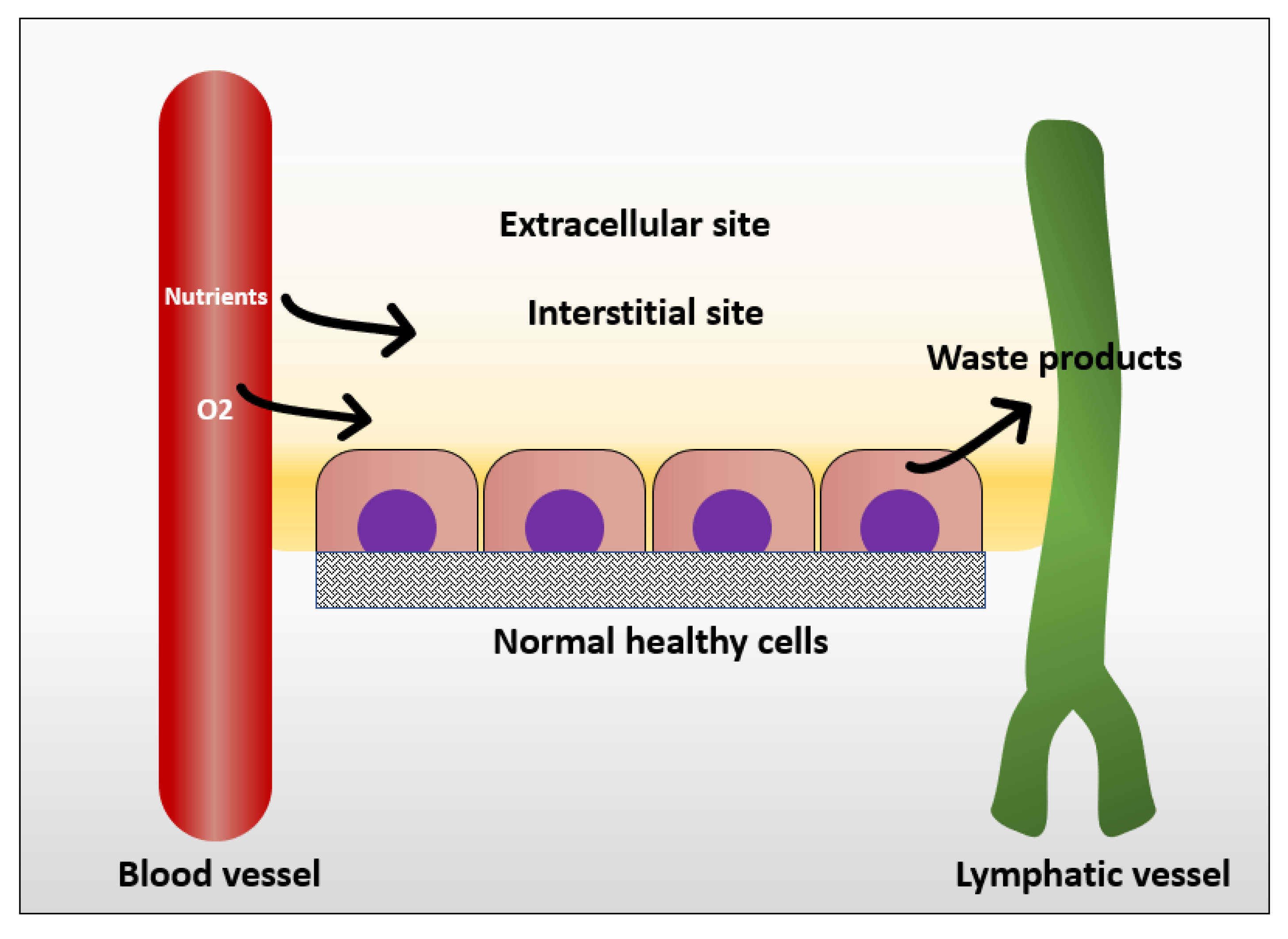
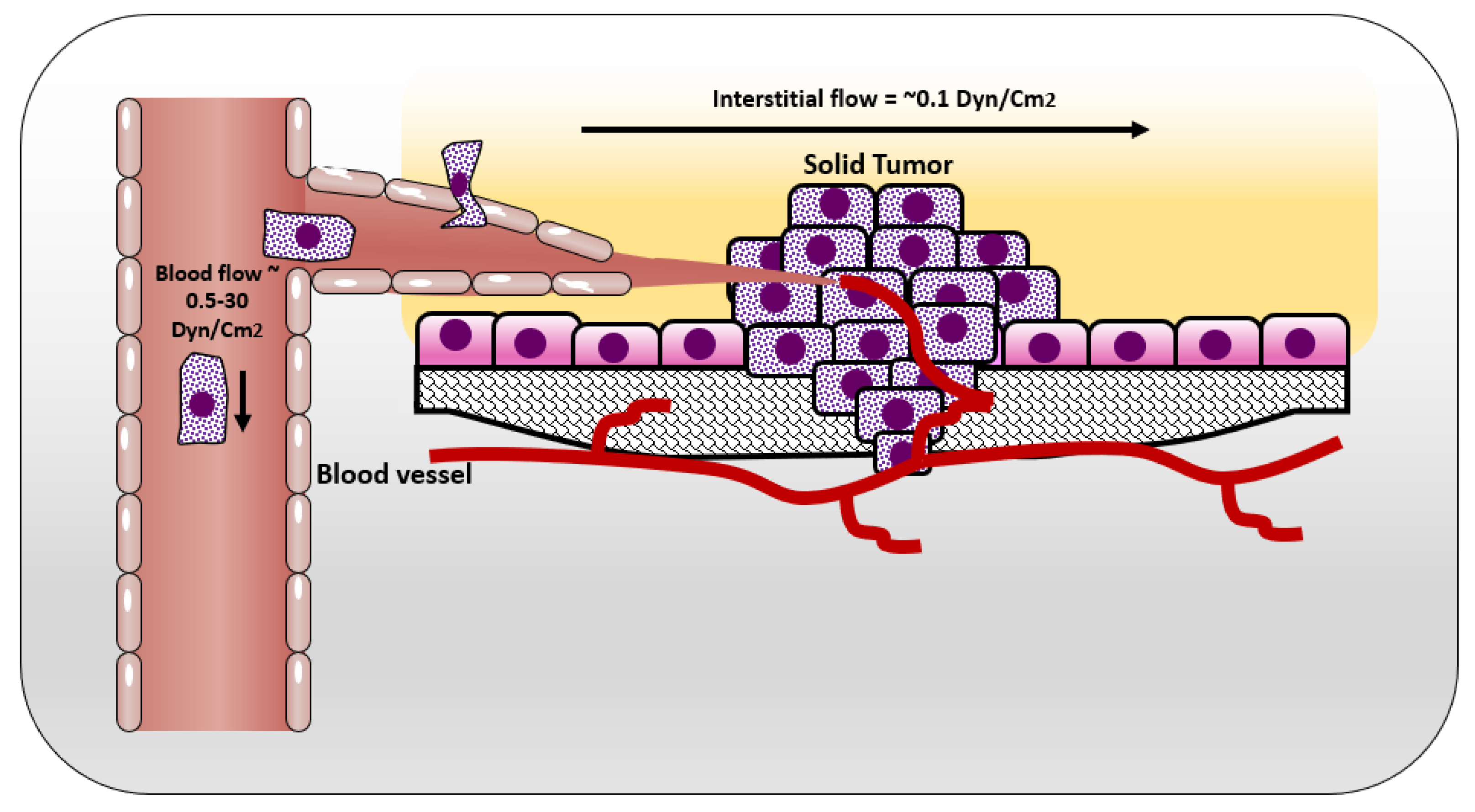
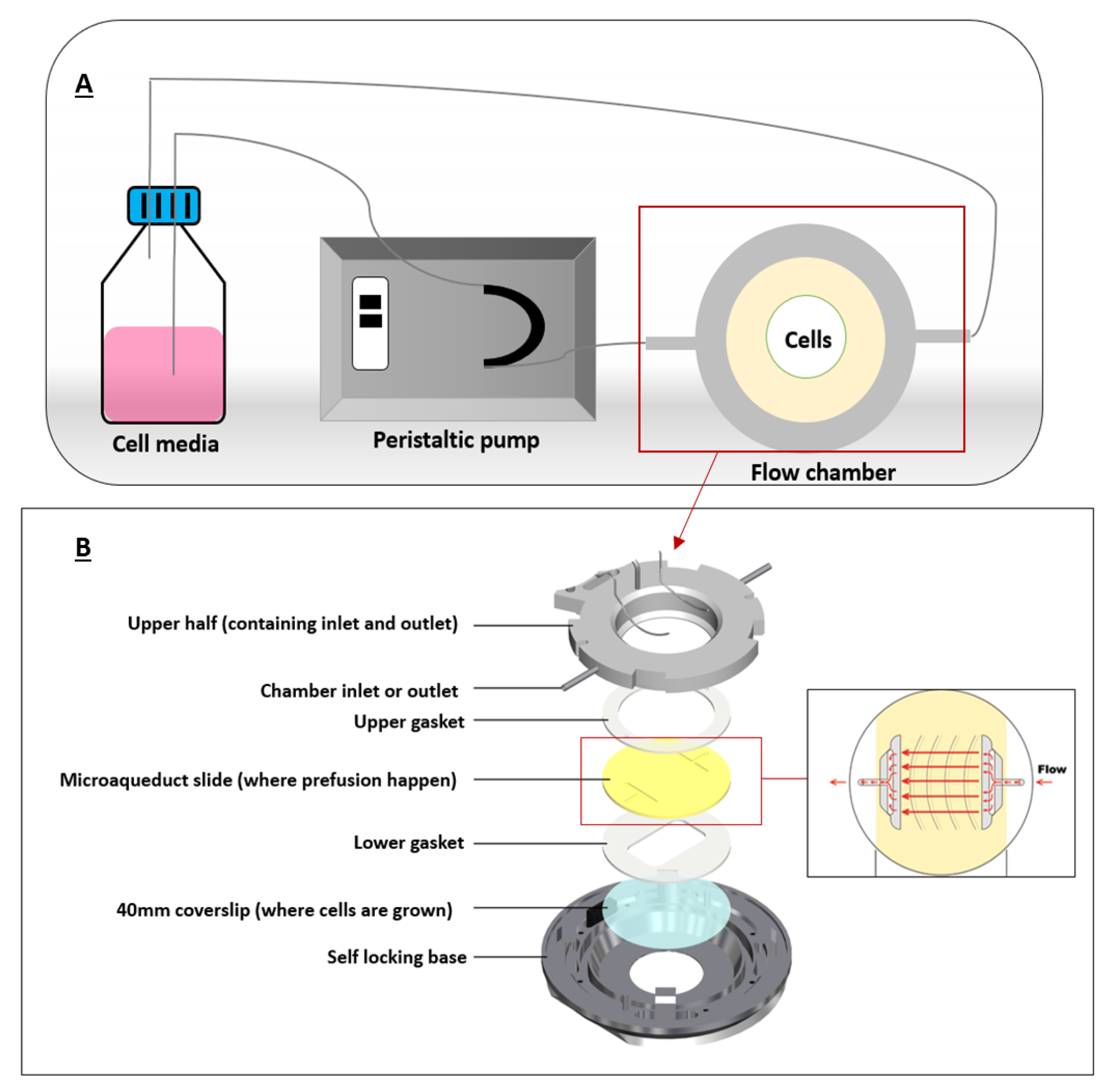
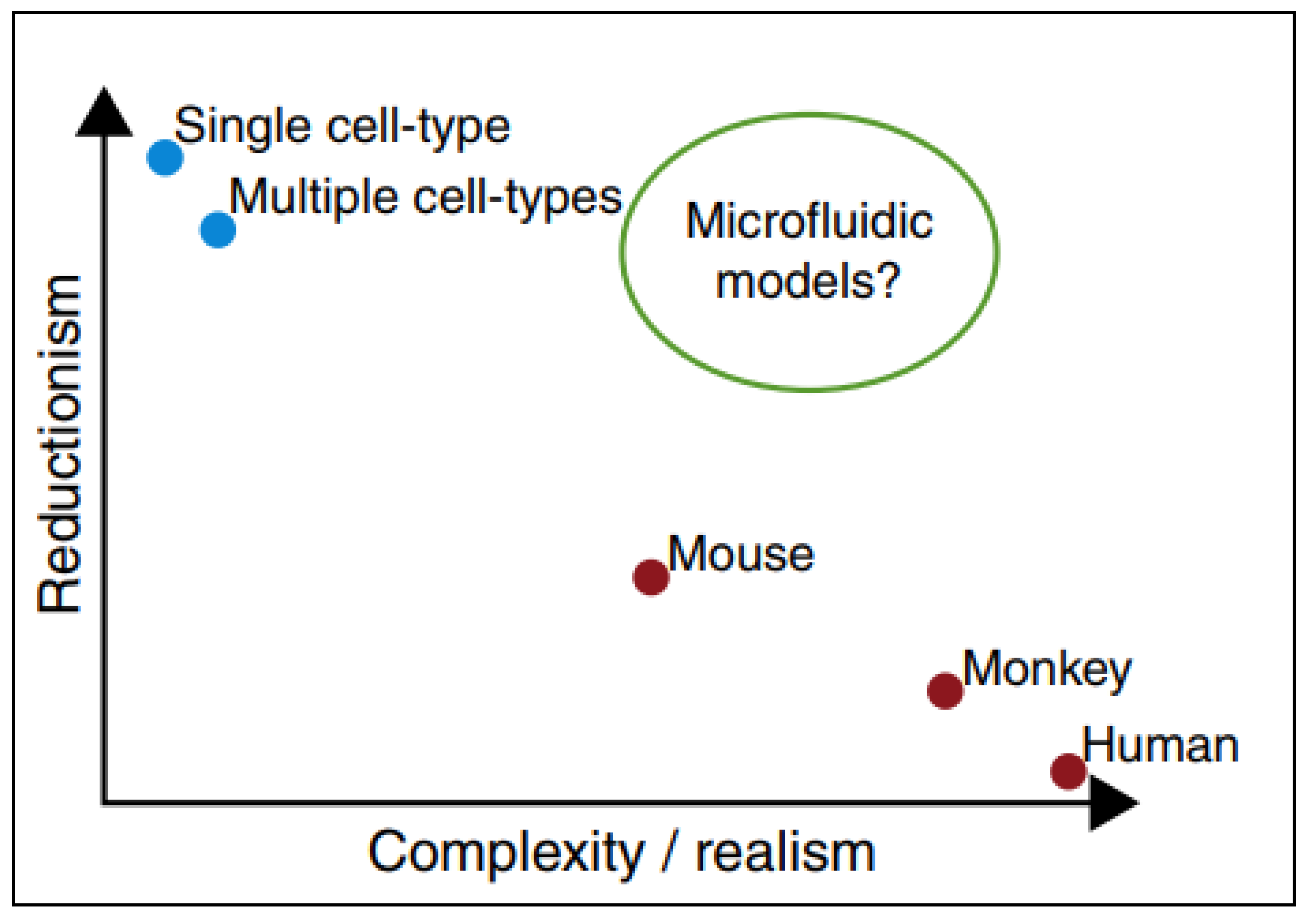
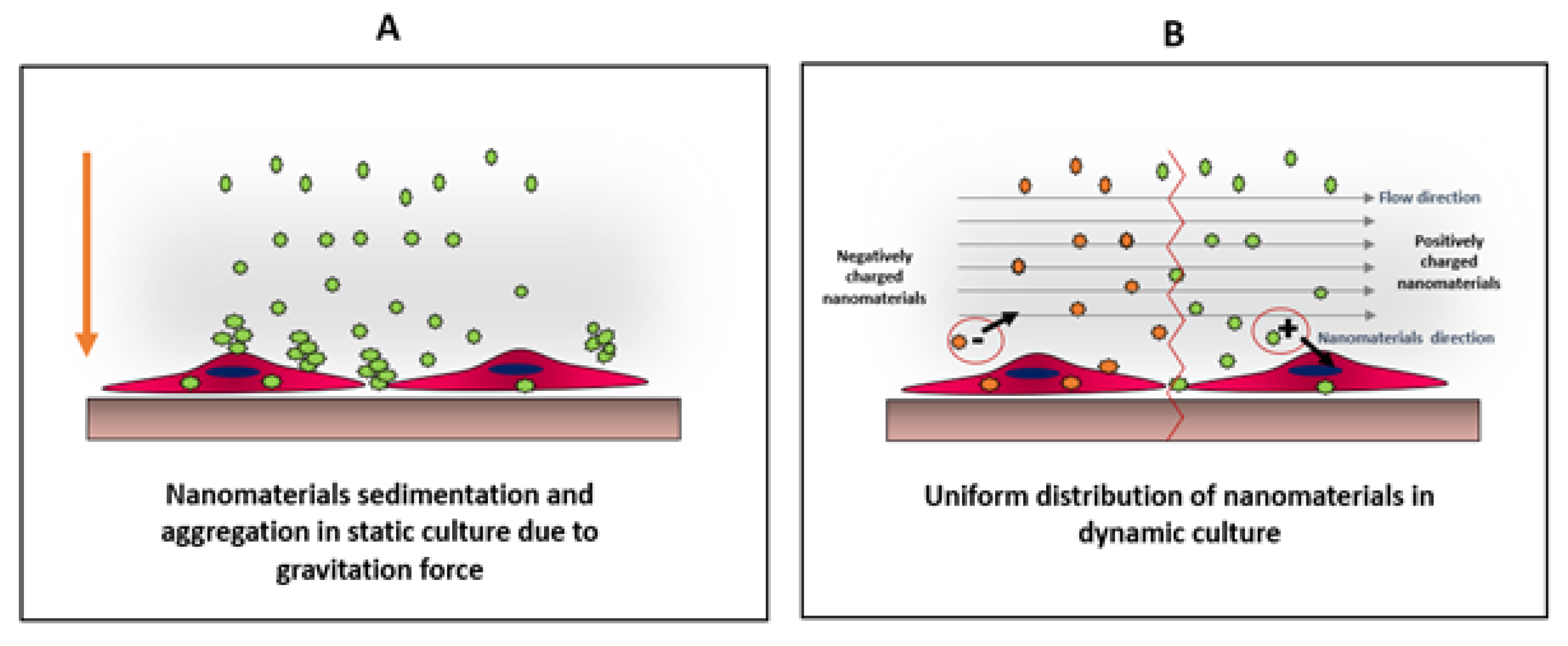
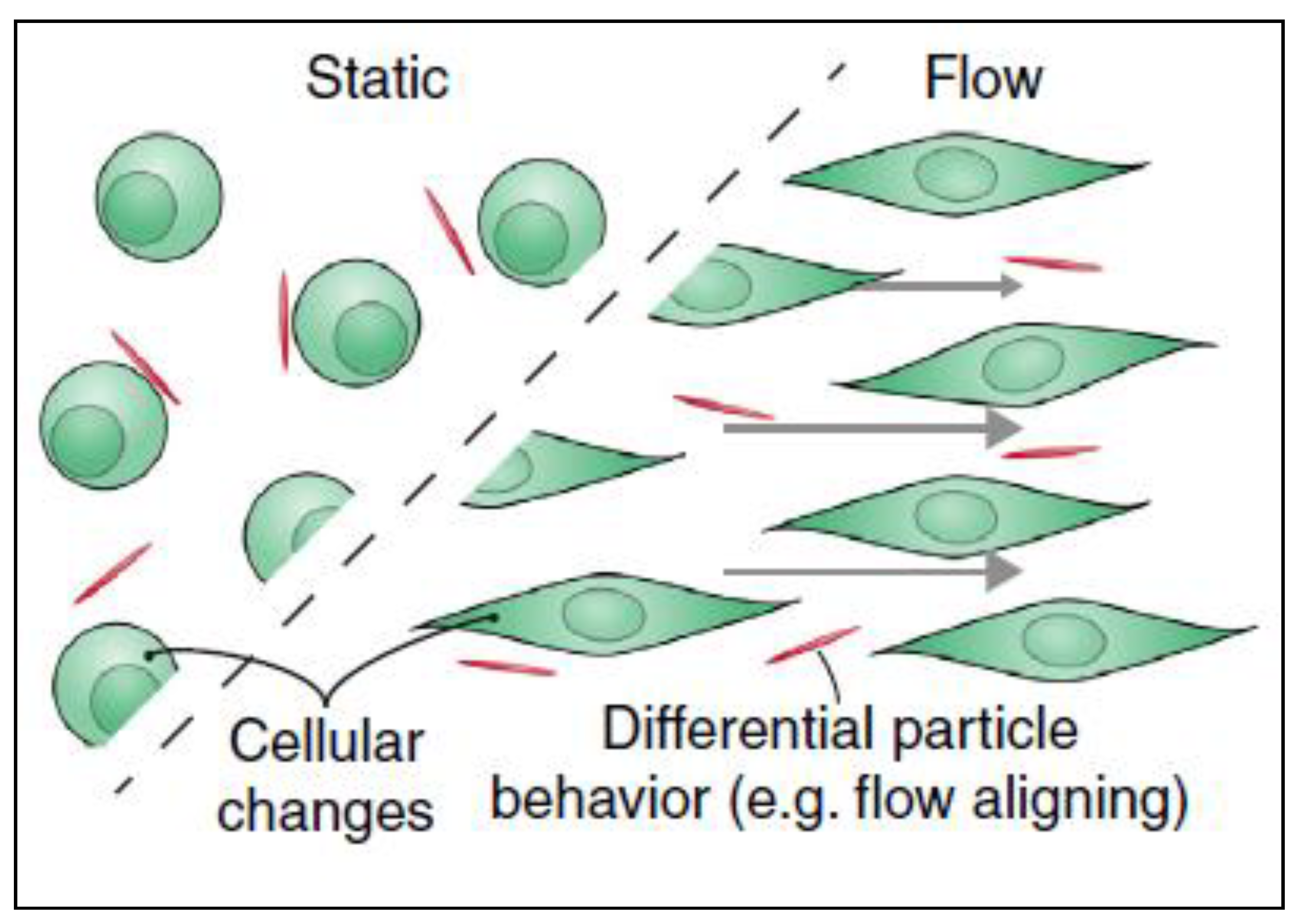

| Fluid Flow | Shear Stress (Dyn/cm2) | Reference |
|---|---|---|
| Interstitial flow | 0.1 | [13] |
| Normal vein | 1–6 | [29] |
| Normal artery | 10–70 | [29] |
| Lymphatic fluid flow | 0.64 | [14] |
| Liver | 0.1–0.5 | [30] |
| Peritoneal fluid flow | <5 | [15] |
| Type & Properties of Nanomaterial Applied | Type of Cells | Flow Conditions | Shear Rate | Findings | Ref. |
|---|---|---|---|---|---|
| Different polymer-based NPs | HUVEC | One-hour incubation under optimum conditions (37 °C, 95% air & 5% CO2) | 0.7, 3, 6, and 10 Dyn/cm2 | Increasing the negative charge increases the uptake under static conditions. Positively charged particles showed more efficient uptake in static culture compared to negatively charged particles. Increasing shear stress is positively correlated with cellular uptake. | [38] |
| PEGylated lipidic NPs. Un-PEGylated lipidic NPs | MCF-7 Hela cells | Incubated under optimum conditions for 5 or 90 minutes under flow speed of 50 cm/s | MCF-7 cells showed significantly lower uptake of un-PEGylated NPs in dynamic culture at both incubation durations. PEGylated NPs showed similar uptake by MCF-7 in dynamic culture and static culture. Hela cells showed a higher NPs cellular uptake after 90 minutes incubation in dynamic culture. | [60] | |
| Negatively charged PEG NPs with different aspect ratios | HUVEC | 1,12, and 24 hours of exposure to dynamic conditions using 0.907 uL/min flow rate. | 10 Dyn/cm2 | Larger particles have higher internalization than smaller ones, under flow in comparison to static culture. | [65] |
| Silica NPs with different densities | RAW 264.7 macrophage cells | 24-hour incubation under flow (cell media agitation) at optimum conditions. | More Uptake in static conditions compared to dynamic conditions. Low density particles have lower uptake in dynamic conditions compared to high density particles. | [67] | |
| Negatively charged NPs | Endothelial cells | 24-hour incubation under optimum conditions. | 0.05, 0.1, and 0.5 Pa | cellular uptake increased with low shear stresses when compared to high shear. | [57] |
| Negative, Positive & Zwitterionic lipidic NPS | Skeletal mouse myoblast cell model (C2C12) | 0.0146 and 0.146 Dyn/cm2 | Higher cellular interaction in the presence of shear for positively-charged NPs compared to negatively-charged lipids or zwitterionic ones. | [58] |
© 2020 by the authors. Licensee MDPI, Basel, Switzerland. This article is an open access article distributed under the terms and conditions of the Creative Commons Attribution (CC BY) license (http://creativecommons.org/licenses/by/4.0/).
Share and Cite
Shurbaji, S.; G. Anlar, G.; A. Hussein, E.; Elzatahry, A.; C. Yalcin, H. Effect of Flow-Induced Shear Stress in Nanomaterial Uptake by Cells: Focus on Targeted Anti-Cancer Therapy. Cancers 2020, 12, 1916. https://doi.org/10.3390/cancers12071916
Shurbaji S, G. Anlar G, A. Hussein E, Elzatahry A, C. Yalcin H. Effect of Flow-Induced Shear Stress in Nanomaterial Uptake by Cells: Focus on Targeted Anti-Cancer Therapy. Cancers. 2020; 12(7):1916. https://doi.org/10.3390/cancers12071916
Chicago/Turabian StyleShurbaji, Samar, Gulsen G. Anlar, Essraa A. Hussein, Ahmed Elzatahry, and Huseyin C. Yalcin. 2020. "Effect of Flow-Induced Shear Stress in Nanomaterial Uptake by Cells: Focus on Targeted Anti-Cancer Therapy" Cancers 12, no. 7: 1916. https://doi.org/10.3390/cancers12071916
APA StyleShurbaji, S., G. Anlar, G., A. Hussein, E., Elzatahry, A., & C. Yalcin, H. (2020). Effect of Flow-Induced Shear Stress in Nanomaterial Uptake by Cells: Focus on Targeted Anti-Cancer Therapy. Cancers, 12(7), 1916. https://doi.org/10.3390/cancers12071916






